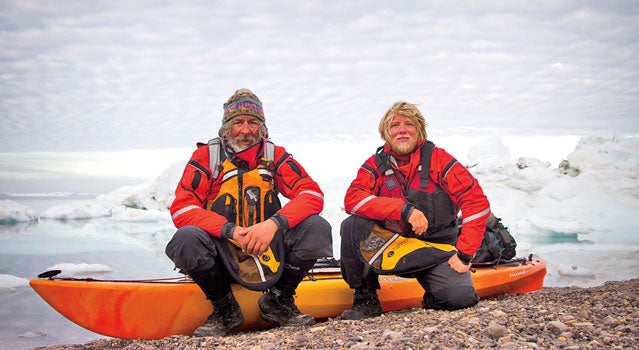There would be polar bears, a brush with kidney failure, and (of course) hunger and shivering. But let’s begin with the walrus. On the 96th day of a three-and-a-half-month Arctic trudge, we were paddling through the ice pack with no sign of danger. Suddenly, a 3,000-pound walrus rose out of the frigid ocean—driven either by anger or curiosity—only inches from my teammate, Erik Boomer. He braced himself and slapped the tusked mammal in the face with his paddle—whack, whack—until it slid back underwater.
The airlift
 The airlift
The airlift“Let’s get out of here!” Boomer shouted over his shoulder. He was already making a wake toward shore.
The expedition, to drag and paddle our sea kayaks all the way around Ellesmere’s 1,500-mile coastline, was meant to be a retirement trip of sorts. I’d been here in 1988, hauling boats up the east coast of the island and then crossing Smith Sound to Greenland, following the route of Qitdlaq, a 19th-century shaman, madman, and murderer. At the time, I’d considered a circumnavigation of the island for the simple reason that nobody had ever done it, but it seemed too difficult. Now that I was 65, the urge had arisen again. So I teamed up with fellow Montanan Tyler Bradt and Boomer, of McCall, Idaho—both world-class whitewater kayakers, and both in their twenties—and we found sponsorship from Eddie Bauer and Polartec.
Seven weeks before we’d planned to leave, Bradt, who holds the world record—189.5 feet—for a kayak waterfall drop, broke his back running a 100-footer. He recovered, but not in time for our trip. I’d met Boomer only a few times, but we decided to go for it. We connected in Ottawa in early May and flew to the hamlet of Grise Fiord, population 141, at the island’s southern tip.
Since prime kayak season extends only from mid-July to mid-August, and since we couldn’t paddle the required 1,500 miles in 30 days, we started in May and set off skiing clockwise around the island, crossing sculpted drifts on a frozen ocean, pulling our kayaks as sleds. In mid-June, we picked up a cache on Ellesmere’s north coast and stuffed our boats with 60 days’ worth of food. Still without open water to float the kayaks, we dragged our 300-pound loads east and then south, waiting for the constant summer sun to fracture the Arctic ice pack and allow us to paddle.
We faced the crux on the northeast corner of Ellesmere, starting July 4. There was movement in the 12-mile-wide strait between us and Greenland, but the channel was choked with an endless parade of churning ice. No kayak could survive that chaos. For 17 days, we watched the ice. Frequently, Boomer would say, “��’m�Dz�, southwest wind”—like someone urging on a losing team.
Finally, at 9:15 on the morning of July 21, open water appeared. We paddled into narrow channels surrounded by moving ice. If it closed in again, we would be crushed. We paddled day and night and made it to the ruins of the 19th-century British stronghold Fort Conger on July 26, still 575 miles from the finish.
It was at this outpost that American explorer Robert Peary, attempting to reach the North Pole, lost eight toes to frostbite in 1899. He later wrote that “a few toes aren’t much to give.”
Ellesmere was hard on Peary and his generation, and it took a toll on us, too. On August 19, we made it back to Grise, our starting point, after 104 days on the ice. But 40 hours after we finished our epic, my body broke down. I could no longer urinate. My blood pressure and metabolic-potassium levels spiked. I later learned that I was suffering from an enlarged prostate, which shut off my urine flow. I’d probably had it for weeks, but I believe that my focus on finishing the expedition caused my body to release cortisol and prevent the disease from becoming acute—until then.
The nurse in Grise listed my condition as life-threatening. Unlike Peary, though, I had an insurance policy with Global Rescue. The Boston-based company dispatched a jet, and I was flown to a hospital in Ottawa. They dropped Boomer on Baffin Island.


